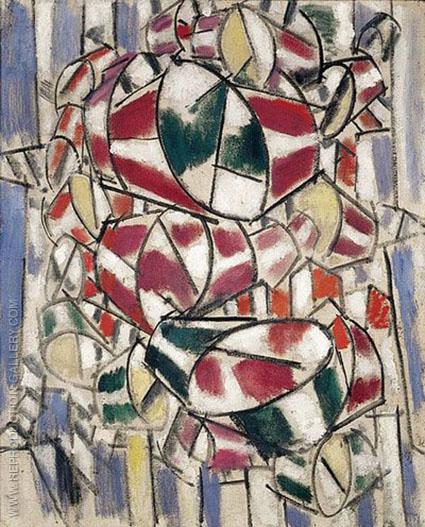Fernand Leger is a french artist that was responsible for the development of “machine art”. Not only was he inspired by cezanne like other artists of this era but also inspired by technology and cubism. He went to first work in Paris as an architectural draftsman. He met several poets and artists and though this gained a heavy interest in cubism.


He produced about 50 versions of these “contrast of forms” paintings on canvas and about 100 on paper. These paintings were created for proving his theory of “ the way to achieve the strongest pictorial effect was to juxtapose contrasts of colour, of curved and straight lines, and of solids and flat planes” (Britannica). Within these paintings he focused on Chiaroscuro which was the illusion of three dimensionality created with lights and darks.

The card party was influenced by his service in WW1 as a military engineer on the front lines. After being released from the army in 1917 he went on to create the card party. He thought of this work as “the first picture in which I deliberately took my subject from our own epoch.” This was his first work to be believed in the mechanical period. This encapsulated his interests in a variety of machinery.

This was considered his masterpiece of his mechanical period because it was a combination of humans and machinery. He also took into consideration their environments.

Léger now gained an interest in the theme of construction workers. in 1940 he had sympathy for the working classes, and had lectured at the time that art should relate/ create a connection to everyone.
Sources
November 12, 2019 at 4:59 pm
Scott,
Excellent work on all of your recent posts, from Poussin to Leger. Your personal insights and comments are most welcome. Great research and well thought out writing. One small thing the Viennese Secession is not spelled with a z. Also you seem to have missed Neoclassicism, Romanticism, and Rococo.
Jeff
November 13, 2019 at 3:51 pm
Scott,
I think I might have left a comment yesterday but I don’t see it here so am commenting again. Anyhow great work on catching up on your posts all the way to Leger. Excellent research and well written. You just seem to have skipped over Neoclassicism, Romanticism, Rococo as I don’t see that one here. Keep up the good work.
Jeff